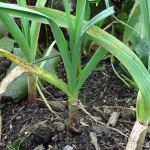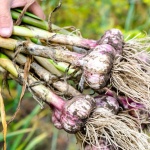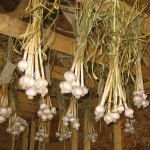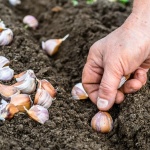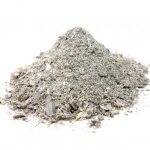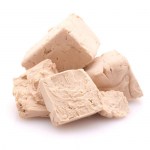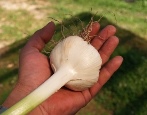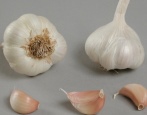
- Authors: Khomyakova E.M.
- Year of approval: 2002
- Sheet length, cm: 40-55
- Sheet width, cm: up to 2.5
- Leaf color: green with medium waxy bloom
- Flower arrow shape: curved
- The form: rounded with an upward slope
- Bulb size: large
- Bulb weight, g: 50-60
- Number of teeth: 10-14
Dobrynya is a winter garlic variety that was bred by Russian breeders. It was approved for use in 2002. This variety is well suited for both private cultivation and commercial cultivation.
Description of the variety
Dobrynya belongs to winter-hardy and high-yielding varieties, it has a high keeping quality, which retains by 80% even when stored for six months. However, it is important that the heads are stored undamaged. After four months of storage, it is advisable to sort out the harvest and select the heads that begin to deteriorate: they can be processed immediately so that they do not disappear.
Characteristics of the appearance of plants and bulbs
This is an arrow-headed garlic with a curving flower arrow, the stem reaches 70 cm in height, the leaves are green, with a waxy bloom.
The bulbs are round in shape, running upwards, large, weighing about 50-60 g, each has 10-14 cloves. The teeth weigh 5-6 grams. Dry scales are grayish-white, veins are purple. Juicy painted in a purple tone. The pulp is light creamy, almost white.
Purpose and taste
The cloves have a semi-sharp taste and a pronounced aroma; they can be used both for adding to a fresh salad and as a seasoning for hot dishes. You can rub the slices for sandwiches, and it is also allowed to dry and grind them.
Maturation
From the moment of germination to yellowing of the leaves, 120-130 days pass, which is typical for late-ripening varieties. The readiness for harvesting can be judged by the condition of the plant. A yellowed tops that have bent to the ground indicates that harvesting can begin. If the heads become overripe, the teeth will begin to separate, and this will complicate the harvesting process, so it is better not to delay harvesting. It is recommended to harvest garlic in dry, sunny weather. After harvesting, the heads are laid out on the street to dry, then the leaves and roots are cut off, and stored.
Yield
Dobrynya brings 2.1-2.5 kg of garlic from each square meter, which indicates a high yield of the variety.
Growing and care
Garlic begins to be planted in the fall. 2-3 weeks before planting, the garden bed should be dug up and rotted manure should be added. If the soil is very poor, then superphosphate, potassium, complex compounds will be relevant. To lighten heavy soil, peat or sand is added to it.
For planting, the largest teeth are chosen, on which there are no damages. They are planted with their bottoms down to a depth of 4-6 cm, leaving 5-10 cm between two specimens and sprinkling with soil on top. There is no need to moisten the landing site. If Dobrynya will be grown in a cold region, then it is recommended to add a layer of mulch, for example, sawdust or straw.
Watering the culture should be moderate, twice a week, make sure that the soil is not waterlogged. An hour after watering, it is advisable to loosen the soil: this procedure prevents the formation of a hard crust on the soil surface, which interferes with the penetration of moisture and oxygen to the roots. It is important to remove weeds as needed, otherwise the heads will be small.
During active growth, top dressing should be applied, which are stopped at the beginning of the ripening period. The first fertilizer can be ammonium nitrate.The second top dressing is applied 2-3 weeks after the first, and now nitroammophoska will become more appropriate. In mid-July, a third feeding will be required, this time the superphosphate solution is relevant.
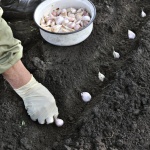
You can plant garlic twice a year. The spring species is best planted in the spring, the winter one is sown before winter. Planting time depends on the region, climatic conditions, varieties, favorable days. It is also necessary to properly prepare the planting material and beds.
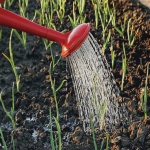
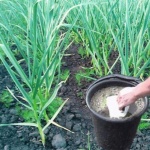
Top dressing of garlic plays a vital role in growing. The use of fertilizers contributes to the rapid growth of heads, an improvement in taste, and an increase in yield. There are many ways to feed him: this can be done with mineral or organic substances, as well as with all kinds of folk remedies.
Disease and pest resistance
Dobrynya has a high immunity to diseases and pests, this variety is highly resistant to fungal diseases, so additional treatments are not required. To maintain the health of the plant, preventive measures are sufficient, which consist in the timely removal of weeds, adherence to the irrigation and feeding regime, and maintaining cleanliness on the site.
